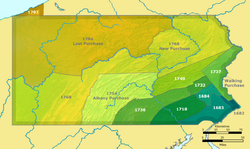
Back Провинция Пенсилвания Bulgarian Province of Pennsylvania German Provincia de Pensilvania Spanish استان پنسیلوانیا Persian Province de Pennsylvanie French פרובינציית פנסילבניה HE Փենսիլվանիա նահանգ Armenian Provincia di Pennsylvania Italian ペンシルベニア植民地 Japanese 펜실베이니아 식민지 Korean
Province of Pennsylvania | |||||||||||
|---|---|---|---|---|---|---|---|---|---|---|---|
| 1681–1776 | |||||||||||
 Map of the Province of Pennsylvania | |||||||||||
 Land purchases from Native Americans in Pennsylvania | |||||||||||
| Status |
| ||||||||||
| Capital | Philadelphia | ||||||||||
| Official languages | English and Pennsylvania Dutch | ||||||||||
| Government | Proprietary Colony | ||||||||||
| Proprietor | |||||||||||
• 1681–1718 | William Penn (first) | ||||||||||
• 1775-1776 | John Penn (last) | ||||||||||
| Governor | |||||||||||
• 1681-1682 | William Markham (first) | ||||||||||
• 1773-1776 | John Penn (last) | ||||||||||
| Legislature | (1683-1776) Provincial Assembly (1776) Provincial Conference | ||||||||||
• Upper house | Provincial Council | ||||||||||
• Lower house | General Assembly | ||||||||||
| History | |||||||||||
• Land grant by Charles II of England to William Penn | March 4, 1681 | ||||||||||
| July 4, 1776 | |||||||||||
| Currency | Pennsylvania pound | ||||||||||
| |||||||||||
| Today part of | United States | ||||||||||
The Province of Pennsylvania, also known as the Pennsylvania Colony, was a British North American colony founded by William Penn, who received the land through a grant from Charles II of England in 1681. The name Pennsylvania was derived from "Penn's Woods", referring to William Penn's father Admiral Sir William Penn.
The Province of Pennsylvania was one of the two major Restoration colonies. The proprietary colony's charter remained in the Penn family until they were later ousted following the American Revolution and the Commonwealth of Pennsylvania was established as one of the original thirteen states. The lower counties on Delaware, a separate colony within the Pennsylvania Province, broke away during the American Revolution and was established as the Delaware State and also became one of the original thirteen states.
The colony attracted English Quakers, Germans, and Scots-Irish frontiersmen. The Lenape Indian tribe promoted peace with the Quakers. However, after William Penn and Tamanend, who both supported peaceful coexistence, died, wars eventually broke out. The Quakers demonized Lenape mythology even though the Quakers were strong proponents of religious freedom.[1]
Philadelphia, the capital of the Province of Pennsylvania, emerged as a major port and commercial city and central location for the thinking, writings, and planning that ultimately inspired the American Revolution. In the 18th century, Philadelphia emerged as the second-largest city in the British Empire, after London. Following the American Revolutionary War, Philadelphia served as the nation's capital until 1800, when a new capital city in Washington, D.C. was constructed.[2]
- ^ Hershey, L. B. (2009). Peace through conversation: William Penn, Israel Pemberton and the shaping of Quaker-Indian relations, 1681-1757 [University of Iowa]. https://doi.org/10.17077/etd.hk7i11nh
- ^ Joseph E. Illick, Colonial Pennsylvania: A History (1976).

